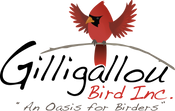When it comes to habitat creation, native plants, shrubs, and trees are the name of the game. With the risk of poisoning or disease often associated with the use of non-native plants, conservationists, horticulturalists, and naturalists all agree that going native is the best for not only our birds but for the ecosystem as a whole.
As many of you are aware, the creation of natural, sustainable habitat is something we take to heart and is a mission statement of us personally and of our Gilligallou Bird business. We have been advocating for the use of natural feed and seed as well as for the creation of bird-friendly natural habitat in our yards and neighborhoods since we began this journey nearly six years ago.
While many of us do not have a difficult time understanding why we advocate for these things, we often field questions more specifically pertaining to birds. As more folks are becoming aware of the benefits to the environment of additional native green spaces, we would also like to shed some light on exactly how it is birds utilize these native trees and plants.
Food
If you have spent any time out in a garden or in the woods, it is no secret that trees, shrubs, and plants of all kinds can and do attract a variety of insects. Trees such as oaks host more than 500 species of butterfly and moth caterpillars, along with many other insects, which are staple items in the diets of many of our migratory bird species.
Orioles and other species also enjoy the sweet tastes they can get from a variety of fruit trees as well as honeysuckle vines, where available. The seeds and leaf buds from oaks and elms are also utilized by many bird species as a necessary and vital food source during the spring months.
Nesting
As we all know, the variety of nesting techniques in the birding world is nothing short of amazing. These astonishing feats, however, require specific characteristics for many bird species to be able to successfully create their nesting sites.

Maples, cottonwoods, and sycamore trees all feature long branches that allow species such as Orioles adequate space for weaving their intricate nests. Additionally, other species utilize more concealed trees and plants such as evergreen trees for both nesting and feeding.


Comments (0)